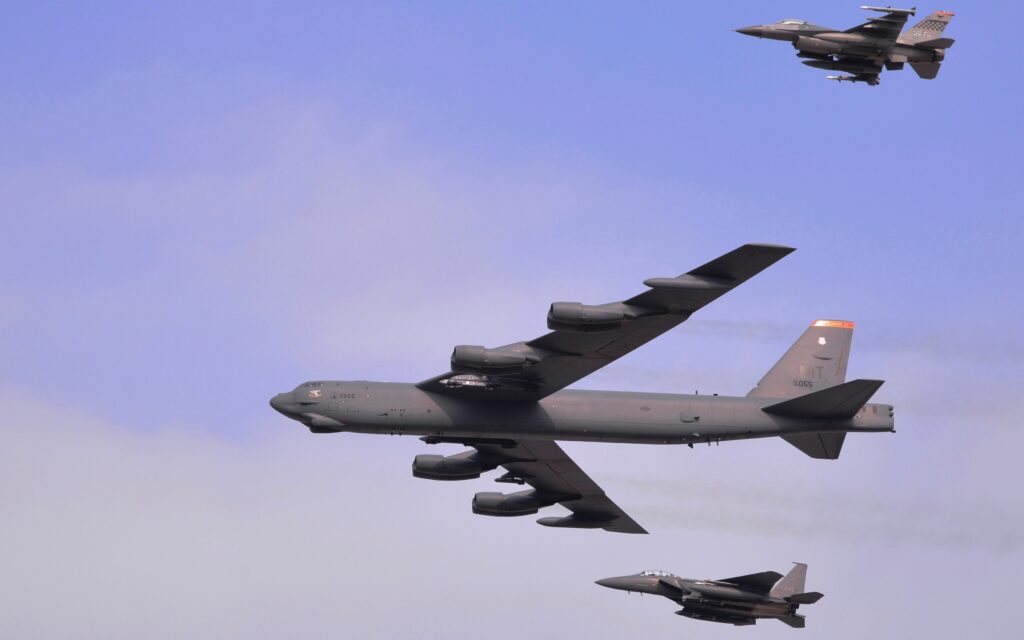Nuclear Bomber Signaling Doesn’t Work
Posted on
In a recent article in Breaking Defense, Adam Lowther and Chris Winklepleck argue that the strategic aircraft leg of the triad provides unique “nuclear signaling” capabilities essential to demonstrating the seriousness of U.S. nuclear threats. But the benefit of using nuclear weapons in this manner is a dubious one, both for America and its allies.
Lowther and Winklepleck claim nuclear flyovers of South Korea in 2013 and 2016 by U.S. B-2 and B-52 aircraft illustrate the value of this “nuclear signaling” with the bomber leg of the nuclear triad.
They are wrong. This aerial flexing of nuclear muscle has done nothing to ease tension on the Korean peninsula or improve North Korea’s behavior. It has raised tensions and provided domestic justification for Pyongyang’s dictatorship, brinkmanship and nuclear weapons program by confirming the existence of an external nuclear threat from the United States. This threat has been claimed by the Democratic Peoples Republic of North Korea (DPRK) since the Korean War, when the United States threatened to use nuclear weapons against it.
The two “long-range show-of-presence missions” by U.S. nuclear bombers did nothing to slow or deter progress of the DPRK nuclear and missile programs. The first flyover of South Korea in March 2013 was followed by North Korea’s restart of its heavy water reactor at Yongbyon in April. In March of 2014 the north test-fired two medium-range No Dong missiles into the Sea of Japan for the first time in five years, violating UN sanctions. And DPRK conducted its fourth nuclear test explosion in January 2016.
Following the second U.S. nuclear flyover by a B-52 bomber shortly after the January nuclear test, the DPRK launched a long-range ballistic missile, again in defiance of United Nations sanctions. In recent weeks Kim Jong-un, the North Korean dictator, has threated South Korea and the United States with pre-emptive nuclear strikes, indicating that he sees the U.S. nuclear flyovers as a bluff that weakens each time it is repeated. If the signal the U.S. Air Force is trying to send is for the DPRK to stand down its weapons building and aggressive rhetoric or else, Kim has not gotten the memo.
Previous attempts to influence the behavior of potential adversaries with nuclear “signals” were equally ineffective. On October 27, 1969 the U.S. Strategic Air Command (SAC) launched a series of B-52 bombers, armed with thermonuclear weapons, on a “show of force” airborne alert, code-named Giant Lance. During this operation, 18 B-52s took off from bases in California and Washington State and approached the Soviet Union from the Artic. The objective of this signal, know as the “madman nuclear alert,” was to convince the Soviets that Nixon was aggressive enough to launch a major bombing attack — perhaps even a nuclear attack — against North Vietnam if Moscow did not pressure the Hanoi government to sue for peace on terms acceptable to the United States. Neither Moscow nor Hanoi got the message.
In June of 2014 and 2015 U.S. nuclear capable B-2 and B-52 aircraft were sent to the UK to participate in NATO exercises. These deployments and exercises were meant to signal resolve in the face of Russian military intervention in Ukraine. According to a Pentagon press release, their purpose was to demonstrate the “ability of the aircraft to forward deploy and deliver conventional and nuclear deterrence anytime and anywhere.”
These deployments had little effect on Russian behavior. In the following weeks and months Russia formally annexed Crimea and sharply increased direct military aid to separatists in eastern Ukraine, supplying troops and heavy weapons including the Buk anti-aircraft missile that destroyed Malaysia Airlines Flight MH17 on July 24, 2014.
Nuclear signaling is a dangerous game with an unimpressive track record. It is perhaps more effective in its second objective, which is to reassure allies of the U.S. commitment to their defense, but even this desired outcome cannot be tested for success. Besides, the Trident missiles aboard U.S. nuclear submarines are constantly providing extended deterrence for all nations under the U.S. nuclear umbrella. This capability remains invulnerable and can deliver nuclear weapons to any point on the globe.
In the majority of situations, including the cases of North Korea, Russia and China’s assertiveness in the South China Sea, sending signals with U.S. nuclear forces are apt to increase tensions, reduce stability and risk unintended escalation. These outcomes can make the chances of conflict more likely; the exact opposite of what is intended. It is better to respond to nuclear saber rattling by potential adversaries by providing diplomatic reassurance to our allies, as well as conventional military assistance that provides them with the means to counter aggression. Nuclear weapons should be kept in the background. They are weapons of last resort and should only be brandished when the very existence of the United States and its allies is threatened.
Jim Doyle is a former nuclear weapons expert at Los Alamos National Lab and author of a range of scholarly papers on nuclear warheads and nonproliferation.
Subscribe to our newsletter
Promotions, new products and sales. Directly to your inbox.

